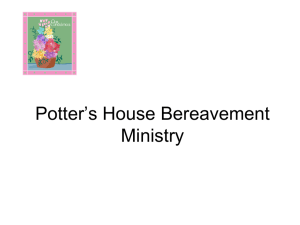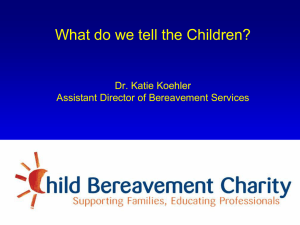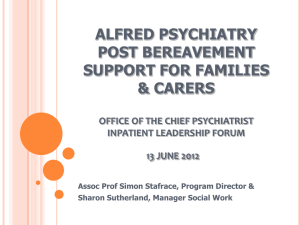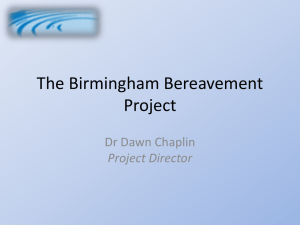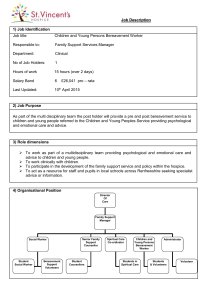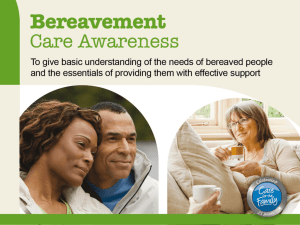Grieving students The response and support of educators in Irish
advertisement
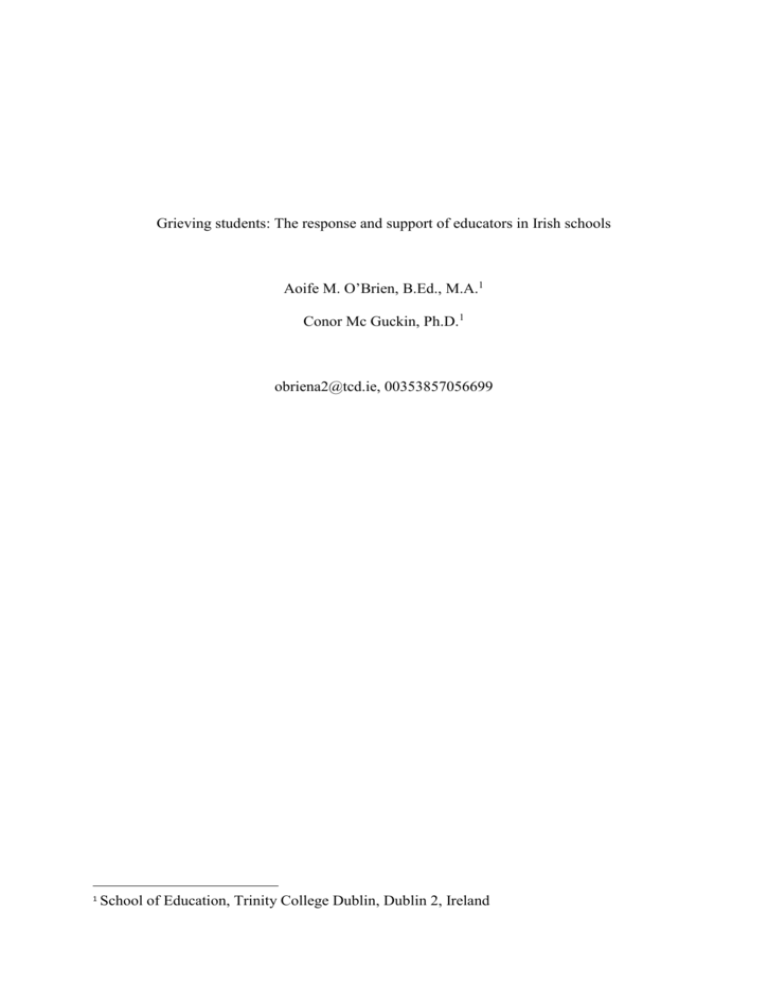
Grieving students: The response and support of educators in Irish schools Aoife M. O’Brien, B.Ed., M.A.1 Conor Mc Guckin, Ph.D.1 obriena2@tcd.ie, 00353857056699 1 School of Education, Trinity College Dublin, Dublin 2, Ireland Grieving Students Abstract It is estimated that bereavement has affected between 36,000 and 60,000 young people in Ireland. Little academic research has been conducted to ascertain the response of Irish schools to bereavement and grief support. The research outlined in this paper documents the approach and response of Irish primary and post-primary schools regarding policy and provision of support to students who have experienced bereavement as well as providing preliminary analyses of exploratory interviews with key stakeholders. The Bereavement Audit Survey was administered to a representative sample of primary and post-primary schools throughout the Republic of Ireland (N = 1,474). A total of 372 questionnaires were returned (achieved rate of 25.24%). The results demonstrate that in the absence of clear advice and support, Irish schools are being proactive and supportive of the students in their care, however, they also indicate the desire for further support in terms of policy, curricula materials, practice direction, staff support, and a Continual Professional Development programme. Preliminary results from exploratory interviews with key stakeholders with a remit in the area of bereavement and loss support are indicative of a need for current resources to be utilised in a more effective manner to increase confidence, governmental support, and training. Keywords Bereavement, education, grief, students, young people. i Grieving Students Introduction Grief can encompass many different forms of loss. The grieving process is often associated with death (e.g., the death of a parent, sibling, friend or even a pet). For the purpose of clarification and focus of the research, this paper will discuss the loss of a significant human relationship through death and thus, this research was designed to find the answer to the question: what do we know about school provision and staff support for a student following bereavement? Currently, there are no Central Statistics Office figures available as to the number of young people who have been bereaved in Ireland. However, we do know the number of deaths that occur each year. In 2012, a total of 28,848 people died in Ireland: 14,778 were males and 14,070 were female (Number of Births, Deaths and Marriages, Central Statistics Office, 2014). If one looks beyond these statistics to consider the young people that could be potentially bereft, this number multiplies and quickly becomes a large percentage of the population of this island nation. In an attempt to estimate the number of grieving young people in Ireland, McLoughlin (2012), extrapolating United Kingdom statistics, has estimated that, at present, there could be between 36,000 and 60,000 who have experienced bereavement. When this number is applied to students attending Irish primary and postprimary schools, it becomes necessary to understand this groups experience within school, and the level of provision that is provided by the Department of Education and staff. A study of youth mental health in Ireland (Dooley & Fitzgerald, 2012) found that the notion of “One Good Adult” is important in the mental well-being of young people; for example, a teacher or Guidance Counsellor could be one such adult. Research recognises how teachers play a vital role in recognising a young person’s grief as well as aiding the psycho-social wellbeing of those in their care (Donnelly, 2001). 1 Grieving Students “While the psychological pain and processes of grief are mostly unavoidable, it is clear the behaviour of those adults relating to young people on a daily basis is a major contributory factor towards what is often referred to as a healthy progress through grief.” (Cranwell, 2007, p. 31). As young people spend one-third of their lives in school, the reactions of teachers and their fellow students are significant, as is the role of the school in ensuring that the needs of those who are bereaved are recognised and responded to in an appropriate manner (Akerman & Statham, 2011; Cranwell, 2007; McGovern & Tracey, 2010). Following bereavement, grief can advance a lack of motivation which has the potential to interfere with the academic education of the student (Abdelnoor & Hollins, 2004; Capewell, 1999; Dowdney, 2000; Kline, Schonfeld, & Lichtenstein, 1995; Mallon, 2011; Rowling, 2003). Common reactions to childhood bereavement, as observed by Capewell (1999), which may subsequently affect a bereaved child in the classroom environment, include: acting rebellious, substance abuse, psychosomatic complaints, changes in behaviour, performance decline, eating problems, specific fears triggered by reminders of the trauma, overwhelming emotions, and a foreshortened future. These negative outcomes call for appropriate care, training, and support from both the school and its staff. Schools have a role to play in challenging the negative and destructive understandings surrounding death by incorporating a comprehensive approach to loss which would endeavour to develop important life skills in young people so as to improve and strengthen school communities (Rowling, 2003). Bereavement may have short-, medium-, and long-term effects on young people’s wellbeing, yet there is little clarity about the kind of support that such young people might need, nor the extent to which it is provided (Akerman & Statham, 2011; Christ, Siegel, & Christ, 2002). 2 Grieving Students Within Ireland, there has been a paucity of research explaining the nature, incidence, correlation, or intervention and organisational support available to bereaved young people. A recent survey of bereavement support services for young people in Ireland (Carroll, 2010) indicates that these services have varying access to training and supervision and do not work to a common set of standards. This research outlines a need for services to demonstrate greater flexibility, more inter-agency working, and greater awareness within communities about the impact bereavement may have on young people and how they can be supported in the future. Research into the support of bereaved students in Ireland has been limited. However, international research indicated that a lack of training and confidence is prevalent throughout many countries. Among a sample of educators in the US (Wass, Miller, & Thornton, 1990) it was discovered that 40 per cent had received little training in grief with only 21.6% indicating that they had received more than two days of training about suicide. Reid and Dixon (1999) indicated that only half of teachers in the US felt that their academic training prepared them to not at all or minimally handle death-related issues as they arise in the classroom. Mahon, Goldberg, and Washington (1999) concurred with this finding and found that only one-third of teachers felt qualified to discuss death with students; with almost 82% of teachers indicating that they were interested in receiving additional training on helping children through grief. Wass et al., (1990) indicated that about 11% of public schools in the US currently implement preventative death education programmes, with elementary schools implementing death education 50% less than middle schools and high schools. However, a large percentage of these death education programmes were implemented for two weeks or less. In a study comparing schools in Australia and England (Rowling & Holland, 2000) all of the Australian schools indicated that individual counselling was offered to students who 3 Grieving Students were grieving. Only four per cent of schools indicated that they received “no training” in the area of bereavement and grief. Ninety-four percent of the Australian schools have reported the existence of a plan to manage critical incidents in schools (Rowling & Holland, 2000). In Denmark, the bereavement response system that has developed is different from those in other European nations with the development of the bereavement response plan (“bplan”), which 96% of all schools today use on a voluntary basis (Lltje, 2013). The Danish approach has developed into a strong and successful supporting system for Danish teachers. Over half of the teachers surveyed by Lytje (2012) reported the system to be so effective that they did not feel the need for any further support on the topic. This is a significant finding that highlights the efficiency of the Danish b-plans, especially when taking into consideration that grief work is not covered in the Danish teacher training curriculum (Lltje, 2012). That Danish teachers do not feel they need more support is welcome since many studies (e.g., Holland, 2008; Lowton & Higginson, 2003) have reported that the majority of their samples wanted further training. At the same time, interviews highlighted that the teachers’ conceptualisation of a good bereavement response came close to the recommendations given by experts on the topic (e.g., Dyregrov a & Yule, 2008; Holland, 2001; Rowling, 2003). In the UK (Rowling & Holland, 2000), 63% of schools indicated that they offered school counselling to grieving students. Schools were generally less supportive in England when compared to Australia which could possibly have been a result of lack of training among staff (Rowling & Holland, 2000). Only 15% of schools in England have a plan to manage critical incidents in schools and only 9% include a loss and grief education which is included as an ad hoc classroom topic and not as an ongoing area in the curriculum (Rowling & Holland, 2000). Fifty per cent of schools indicated that there was “no training” in the area of bereavement and grief support with 28% or respondents indicating that the main method of schools learning from grief was their personal experience (Rowling & Holland, 2000). Just 4 Grieving Students 6% of respondents reported that they thought there were enough training opportunities in the area of bereavement and loss (Rowling & Holland, 2000). This concurs with research by Shipman, Kraus, and Monroe (2001) which found that 56% of teachers in the UK feel inadequate in working with young people who have been bereaved. Similarly, Holland (2007), found a “training gap” in the area of loss and bereavement; it was rated highly in importance but schools lacked the skills necessary to support their pupils and 58% of schools continued to report that more training was needed in the area. Cranwell’s UK study (2007), noted that many bereaved young people identified a need for someone to talk to among school staff. Cranwell (2007) noted that bereavement support resources needed to be part of the “tool kits” of all professionals responsible for child care. Studies undertaken in UK schools (e.g., Holland, 1993, 2000; Lowton & Higginson, 2003) have indicated that often little is done to support grieving children. This lack of response is mainly attributed to the fact that most UK schools do not have any pre-planned approaches on how to deal with bereavement. Holland (1993) reasons that one of the most effective ways to improve the bereavement response is to introduce formalised approaches outlining how the school should respond. The research that has been conducted in Ireland (e.g., McGovern & Tracey, 2010) found that Irish schools regard death as a high priority. Research by McGovern and Barry (2010) has indicated that there is a need to take account of the fact that teachers and parents (especially men), whilst positive towards and supportive of death education for students, feel uncomfortable talking to young people about death. In comparing child bereavement and loss responses and needs of schools in Hull (United Kingdom) and Derry (Northern Ireland), Tracey and Holland (2008) reported that training for teachers, pupils, and parents could help to develop a deeper understanding of the effects of bereavement, thus allowing educators to respond appropriately. 5 Grieving Students While there are many organisations in Ireland that can provide support, these are predominantly aimed at adults; where support is offered to young people, it is often through trained volunteers rather than professional therapists (Dowling, Kiernan & Guerin, 2007). It is clear that in Ireland, while the research that has been conducted has been helpful, further research is needed to explore what provision is available in primary and post-primary schools in Ireland to support students who have been bereaved. This becomes especially important in the context of the recent guidelines from the Department of Education and Skills (2013) regarding the continuum of support that should be available to every student in primary and post-primary school from every adult. Thus, the next section will outline how a Bereavement Audit Survey (N = 1,474) in early Spring 2013 explored issues on policy, guidance, programmes used, staff response, confidence and competence, educational attainment, physical and psychological well-being. 6 Grieving Students Methods A Bereavement Audit Survey (based on Corcoran & Mc Guckin, 2014; Mc Guckin & Lewis, 2008) conducted in early Spring 2013 in primary and post-primary schools (N= 1,474) across the Republic of Ireland, explored responses on policy, guidance, programmes used, staff response, confidence and competence, educational attainment, physical and psychological well-being. The final results of this audit survey are presented. Exploratory interviews also took place. Preliminary thematic analyses for these interviews with key stakeholders and organisations with a remit in the area of bereavement and support are also presented. Ethical Approval Ethical approval for the study was granted by the Ethics Committee of the School of Education, Trinity College Dublin, Ireland. All schools invited to take part in the survey were informed that they would not be identified individually, and that all data collected would be aggregated for the purpose of analysis and reporting. All those partaking in interviews were told of their right to withdraw at any time and all analyses are presented anonymously. Sampling and Procedure The survey was administered to a representative sample of primary schools (n = 752: 22.79% of all primary schools [N = 3,300]) and all post-primary schools (N = 722) in the Republic of Ireland (N = 1,474 in total). The primary school sample was drawn by random selection from the list of primary schools (including disadvantaged schools [n = 665] and special 7 Grieving Students schools [n = 141]) made available by the Department of Education and Skills (2013a, b). Sampling for the primary school sample reflected proportional weightings to reflect (a) enrolment numbers, (b) location of school by geographical county; (c) classification of disadvantage, and (d) school type (i.e., National School [state funded], Educate Together school [non-religious ethos], Gael Scoileanna [Irish language school]). Data analyses are presented in relation to 372 returned questionnaires (achieved rate of 25.24%). There were 169 completed questionnaires received from the primary sector (achieved rate of 22.47%) and 203 from the post-primary sector (achieved rate of 28.12%). 8 Grieving Students Results Bereavement Audit Results Results are presented in relation to the three central thematic areas of the Survey (i.e., About your School; About your Staff; About your Students). As well as providing the quantitative data regarding the responses received, pertinent quotes identified through thematic analysis (Braun & Clarke, 2006) are provided. Due to the unequal numbers of responding primary and post-primary schools, all data analysed is presented without distinction to the two sectors to make it more accessible to the reader. However, three appreciable differences in results occurred between primary and post-primary respondents. These are outlined in Table 1 and are discussed later. Table 1 Comparison between Primary School (PS) and Post-Primary School (PPS) Results (PS) %/n 49.4 / n = 83 Yes (PPS) %/n 70.3 / n = 137 (PS) %/n 46.4 / n = 78 (PPS) %/n 21.0 / n = 41 Not Sure (PS) (PPS) %/n %/n 4.2 / 8.2 / n=7 n = 16 Is the area of bereavement addressed in your school curriculum? (e.g., S.P.H.E.) 52.7 / n = 87 73.1 / n = 147 29.7 / n = 49 6.0 / n = 12 17.6 / n = 29 20.9 / n = 42 Has anyone in your school received training in the area of bereavement / loss in childhood? 27.5 / n = 46 69.3 / n = 140 61.7 / n = 103 13.9 / n = 28 10.8 / n = 18 16.8 / n = 34 Is the issue of bereavement addressed in any other policy documents in your school? No About Your School 9 Grieving Students Each respondent was asked a series of questions related to “About your School”. The series of questions explored the locality, religious denomination, school policy, organisational and departmental directives, formal procedures and programmes, as well as curriculum areas dealing with bereavement and loss. Presented in Table 2 below is an overview of the pertinent questions that will be explored in this section. Table 2 Audit questions and responses to “about your school” Question Yes %/n Do you have a bereavement policy 19.9 / n = 72 in your school? No %/n 80.1 / n = 290 Not Sure %/n - 25.8 / n = 77 25.8 / n = 75 49.2 / n = 147 12.3 / n = 45 72.2 / n = 265 15.5 / n = 57 Do you receive information from any other organisation regarding bereavement issues in school? 51.7 / n = 186 41.7 / n = 150 6.7% / n = 24 Have you sought help from outside service if a child has been bereaved? 54.6 / n = 190 37.6 / n = 131 7.8 / n = 27 If you do not have a bereavement policy, are you considering implementing one in the future? Do you receive any directives from the Department of Education regarding bereavement? In relation to the approach adopted by the school regarding policy and support for students, almost two-thirds of schools (58.7%, n = 214) rated the area of bereavement in terms of priorities of importance as either important or very important. However, whilst more than three-quarters of schools (80.1%, n = 290) reported that they did not have a bereavement policy in place., as can be seen in Table 2, seven out of ten schools (74.3%, n = 222) reported that either they would not consider implementing one, or that they were unsure about whether or not they would implement one. Almost three quarters of schools (72.2%, n = 265) reported that they had not received any directives from the Department of Education and 10 Grieving Students Skills. Nearly one-fifth (15.5%, n = 57) of schools were unsure if they had received any directives with less than one third (26.1%, n = 92) of schools reporting that they had a formal procedure in place. One school indicated that they would “Wait for the child to initiate the approach” while some schools (n = 8) indicated that the bereavement is “Treated sensitively on a case-by-case basis . . . ”. More than half of the schools (60.7%, n = 207) reported that they had a support programme (e.g., Rainbows, Seedlings, Seasons for Growth) in place to help deal with the area of loss. As can be seen from Table 2, more than half of schools (51.7%, n = 186) indicated that they had received information and support from organisations other than the Department of Education and Skills (e.g., Barnardos, Health Service Executive, Institute of Guidance Counsellors, National Educational Psychological Service, Rainbows). About Your Staff Section three examined a series of questions entitled “About your Staff”. This section explored the form of training received by staff and asked whether staff had requested more information on bereavement and grief. This section also explored whether the religious ethos of the school influenced the way in which staff dealt with their students following bereavement as well as other areas of loss that students experienced. As can be seen from Table 1, more than two-thirds of post-primary schools (69.3%, n = 140) indicated that their staff had received training in the area of bereavement and loss, whereas only 27.5% of primary schools (n = 46) indicated likewise. When asked to specify the provider of this training, the majority indicated that it was provided by services such as Rainbows, Seedlings, and Seasons for Growth. The remaining schools noted that, through their educational and professional training, Guidance Counsellors, Chaplains, and Religion 11 Grieving Students teachers were qualified and trained to support students in these areas. Schools indicated that a beneficial form of support for school would be, for example: “A programme to train teachers how to cope with bereavement situation[s] and educate teachers on where we can get help [and] advice. . . ” or perhaps a: “Module that could be covered with classes – cross curricular – to include all ‘loss’, allow students to discuss, share experiences. . . ” More than 286 schools reported that another area of loss that may affect aspects of a student’s development is that of marital breakdown: “I feel quite strongly about the issue of parental sep[a]ration and the traumatic effects it has on young people. There is support after a death but not a lot after sep[a]ration and then there are the access arrangements etc[.] to be dealt with.” About your Students Section three examined a series of questions entitled “About your Students”. These included topics relating to the impact of bereavement on the academic attainment of the student and how, when bereavement occurs, it is communicated to students. This section also explored the issue of whether or not bereavement was an “at home” issue that should be dealt with by the family, and not the school. Additionally, the idea of a “Life Skills” programme, which 12 Grieving Students would deal with issues of bereavement and grief, was introduced and it was asked whether or not a subject like this would be beneficial to educating and supporting students. Table 2 About your Students Question 1. From your experience, does bereavement impact negatively on educational attainment? 2. 3. Do you feel that bereavement is an “at home” issue that should be dealt with by the family (not the school)? Yes No Not Sure %/n %/n %/n 66.6 / n = 237 10.1 / n = 36 23.3 / n = 83 3.8 / n = 14 88.2 / n = 321 8.0 / n = 29 22.9 / n = 83 77.1 / n = 279 - 85.4 / n = 310 2.8 / n = 10 11.8 / n = 43 4. Do you feel that your school needs further support in the area of bereavement? 5. Do you think that a “Life Skills Programme”, which could involve coping with bereavement, would be beneficial for students? More than two-thirds of schools (66.6%, n = 237) responded that bereavement was a factor that could have an impact on the educational attainment of their students. Nine out of ten schools (88.2%, n = 321) felt that bereavement was an issue to be dealt with in school, as opposed to it being an isolated occurrence to be dealt with “at home” by the family. As can be seen from Table 2, almost eight out of ten schools (77.1%, n = 279) expressed that they needed further support in the area of bereavement and loss. Forms of support indicated to be of interest to schools included a: “A member within staff trained specifically to deal with bere[avement] / sep[aration] issues of student.”; “Whole staff training”; or perhaps “… a workshop on grief / loss could be useful for the entire staff . . . ”. Almost nine out of ten schools (85.4%, n = 310) felt that a “Life Skills Programme”, which could involve coping with bereavement, would be beneficial for students. 13 Grieving Students Preliminary Interview Results To triangulate the information provided by the systematic literature review and by respondents to the Bereavement Audit Questionnaire, it was necessary to investigate the role that organisations play in the support of young people who have been bereaved. Thus, the key organisations with a remit in the area were identified. To date, four interviews have taken place each documenting the approach and response of the various organisations regarding the provision and support available for young people who have experienced a significant human bereavement. Questions explored issues relating to the role of the organisation, availability of the service to young people, the established link between schools and the organisation, and areas where bereavement support needs to be improved both internationally and nationally. Interviews are still being conducted and thus preliminary analyses of the transcripts from the initial completed interviews are presented. The following themes highlight four preliminary areas that have emerged from the data to date: (i) lack of confidence; (ii) lack of training and / or information; (iii) lack of governmental support; and (iv) the human response. Lack of Confidence A common theme that emerged is the lack of confidence among educators when supporting bereaved students: “. . . they’re not confident about supporting those kind of children, they don’t know what to say, how to make things worse, how not to make things worse.” 14 Grieving Students The notion of “making things worse” was commonly expressed: “. . . many teachers are terrified of saying something that is going to do more damage. . .” With one interviewee noting that “. . . teachers very often … they will say things like, just tell me the words to say, what am I supposed to do?” This lack of confidence could be attributed to the next emerging theme which identified the lack of training and information for educators as a cause of concern. Lack of training and / or information A general consensus is that there is “. . . a lack of training and of information and of knowing what to do in particular circumstances.” With an agreement that “. . . all teachers need to be trained in bereavement, grief, and loss, and how to make a response.” However, there was the concern that the area of bereavement support in schools is “a closed door” due to lack of knowledge and understanding of the role of the school: “. . . what is the role of the school, is it the academic? Of course it is the academic, but it is wider, children are coming to school with more than just the bags on their back . . .” It was indicated that while teachers may be looking for information, appropriate material may be hard to source: “. . . teachers are looking for it but they don’t know where to go and I suppose if we are being honest, there is no place.” 15 Grieving Students This area coincided with the next emerging theme which noted that there was a lack of governmental support from the Department of Education and Skills. Lack of Governmental Support Any kind of loss can be seen as a barrier to learning, and an area that needs to be supported. However, it was felt that in Ireland there is a lack of “method” and that “… there is no method, there is no direction, no leadership from, you know, from the Department or the Curriculum areas in this matter.” Due to this lack of support, it was indicated that the teacher is left to respond in a “human” manner. The Human Response Overall, the general consensus of the interviewees was that of the “human response” and how important it was “… to know how to respond humanly.” It was highlighted that it was important to know: “How to talk, what you can do, reassuring and confidence building in a very human sense rather than coming in at too high a level . . .” One interviewee relayed a case about a mother who had called a bereavement organisation about her child who had lost her grandfather: “. . . she was really upset, her dad had died, this was this child’s granddad and the child came home from school that day and nobody in the whole school had known, 16 Grieving Students even though they did know and I am not criticising the teacher here. Perhaps she didn’t know how to. . . there’s no training about how to meet that in a classroom situation, but this nine year old was devastated because granddad lived with them and nobody mentioned it, and it’s that piece that was missing.” This case example demonstrates a lack of confidence, training, and information on how to support young people who have experienced bereavement. If educators received Department of Education and Skills approved training and information about how to respond to those who have experienced a loss, a more appropriate and “human” response may follow. 17 Grieving Students Discussion This paper has asserted that there is a distinct lack of empirical knowledge about the nature and effects of bereavement and grief among children and young people in Irish schools. Whilst most knowledge thus far has been gained from clinical research, with the notable exception of previously mentioned research (Carroll, 2010; Dooley & Fitzgerald, 2012; McGovern & Barry, 2010; McGovern & Tracey, 2010; Tracey & Holland, 2008), there is a need to supplement this body of knowledge with the results of theoretically planned and educationally focused research. For the most part, what is known about, or planned for, in the field of Irish education regarding bereavement and grief has a distinct focus on “critical incidents” as opposed to more “normative” bereavement and the ensuing grief responses that are more typical (e.g., Department of Education and Science, 2007). There are a high number of schools without a bereavement policy or formal procedure in place which poses the question of how equipped schools are at supporting young people who have experienced a significant human bereavement. While it is a positive outcome that schools recognise that the issue of bereavement cannot be divorced from the school environment, and that the school community has a role to play in grief support, nearly threequarters of schools have indicated that they do not receive directives from the Department of Education and Skills. Thus, schools are receiving information from others organisations throughout Ireland. More than half of schools (54.6%, n = 190) had actively sought help from outside services (e.g., Barnardos, Child and Adolescent Mental Health Services, 18 Grieving Students National Educational Psychological Service, Health Service Executive, Rainbows, Samaritans). While this may appear positive, it raises the issue of working to a common set of standards, as schools may be receiving contradictory information and could be providing students with a varying range of support, including support that is not evidence informed or externally validated for its accuracy. When responding to such personally upsetting circumstances, it is incumbent upon all in the educational community to ensure that resources, supports, and training programmes are robust and certified, and not just the result of good intentions. While it is positive that more than half of the combined result from primary and post-primary schools are indicating that their staff have received training, when this number is analysed in depth, is seems that the training received lacks accreditation. Schools are indicating that guidance counsellors, chaplains, and religion teachers are trained to support young people in this area; however, there is no specific, obligatory training during these programmes. Furthermore, some schools indicated that their staff were trained during the one- and two-day training sessions provided by Rainbows, Spectrum, Seedlings, and Seasons for Growth. These training days are not accredited or Department of Education and Skills approved. While many schools found these programmes (e.g., Rainbows, Seedlings, Seasons for Growth) supportive, many of the post-primary schools indicated that getting students to participate was difficult: “The programme is helpful. The most difficult part is getting a cohesive group of students to commit to it. It does offer a safe environment to address the emotions [and] changes that are part of the grieving experience. It is therapeutic [and] also builds bonds of fellowship among students.” 19 Grieving Students It was interesting to note that while schools already have a Social, Personal, and Health Education Programme (SPHE), which has a strand area that deals with the issue of loss, more than eight out of ten schools (85.4%, n = 310) stated that a “Life Skills Programme” which dealt with bereavement and grief would be beneficial. Combining this with the large percentage who do not have a bereavement policy (80.1%, n = 290) and would not or were “not sure” (75.0%, n = 222) as to whether or not they would consider implementing one, this could leave one to surmise that perhaps there is a need for the development of more practical resources and training for adequate and standardised bereavement support within schools. Overall, the research has shown that schools are positive, supportive, and proactive whilst also indicating the desire for further support in terms of policy, curricula materials, practice direction, staff support, and Continual Professional Development programmes. Schools have reported their awareness that bereavement has an impact on education and that it is an issue for the school community as a whole in planning to support a young person through the grieving process. However, caution also needs to be exercised in relation to the interpretation and extrapolation of these results, in that it could also be argued that the results are not representative of schools across the country, due to the fact that participating schools in the present sample were self-selected, thereby potentially representing only those schools with a positive and proactive approach to such matters (Mc Guckin & Lewis, 2008). As the current research programme was conducted independently of either the Department of Education and Skills or the trade unions, it could be argued that without any potential punitive measure in relation to non-completion of the questionnaire, some principals may have felt less than compelled to either participate in or provide further feedback in this research, especially if they had undertaken little work in this area. Thus, it is entirely possible that the responses reported upon in the current research are from those schools that operated a positive and 20 Grieving Students child-centred pastoral care ethos that extended to the protection of children from the effects of bereavement and grief. Conclusion Research has continually and robustly illustrated the negative impact of bereavement on young people across their educational, emotional, social, and physical wellbeing. Acknowledging this research raises the issue of potential barriers to education and how bereavement, grief, and loss affect a young person in the school environment. Therefore, it is timely and necessary that an in-depth programme of research is planned and actioned to investigate the needs of young people bereaved in Ireland and how the education system can provide support. A large proportion of respondents who said they believed that further support is needed in their schools. Thus, additional resources and training for educators is required in order to support bereaved young people. It is of social, pedagogical, and national interest to optimise the bereavement provision available to young people in order to minimise long-term difficulties. 21 Grieving Students Acknowledgments This research is funded by the Irish Research Council (IRCHSS). 22 Grieving Students References Abdelnoor, Adam and Sheila Hollins. “How children cope at school after family bereavement.” Educational and Child Psychology 21, no. 3 (2004) 85-94. Akerman, Rodie and June Statham. “Childhood Bereavement: A rapid literature review.” Research Report, Childhood Wellbeing Research Centre, 2011. URL http://webarchive .nationalarchives.gov.uk/20130401151715/https://www.education. gov.uk/publications/eOrderingDownload/Childhood%20bereavement%20literature% 20review.pdf Capewell, Elizabeth. Disaster: How can schools respond? In Children bereavement and trauma: Nurturing resilience, edited by Paul Barnard, Ian Morland, and Julie Nagy , 31-39. London: Jessica Kingsley Publishers, 1999. Carroll, Brid. Survey of childhood bereavement services in Ireland. Masters Thesis,The Royal College of Surgeons in Ireland, 2010. 23 Grieving Students Christ, Grace, Karolynn Siegel, and Adolph Christ “Adolescent grief: It really never hit me until it actually happened.” The Journal of the American Medical Association 288, no. 10 (2002): 1269-1278. Cranwell, Brian. Bereaved children’s perspectives on what helps and hinders their grieving. England: Child Bereavement Charity Project & Sheffield Hallam University, 2007. Department of Education and Skills. “Wellbeing in Schools: Guidelines for addressing Mental Health Promotion and Suicide Prevention in Post-Primary Schools.” Dublin: The Stationary Office, 2013. Donnelly, Pat. Someone to talk to: A handbook on childhood bereavement. Dublin: The National Children’s Resource Centre, 2001. Dooley, Barbara and Amanda Fitzgerald. “My world survey: National study of youth mental health in Ireland.” Research Report, Headstrong & University College Dublin, 2012. URL https://www.headstrong.ie/sites /default/files/My%20World% 20Survey%202012%20Online.pdf Dowdney, Linda. “Childhood bereavement following parental death.” Journal of Child Psychology & Psychiatry 41, no.7 (1999): 819-830. Dowling, Mairead, Gemma Kiernan, and Suzanne Guerin. “Responding to the needs of children who have been bereaved: A focus on services in Ireland.” The Irish 24 Grieving Students Psychologist 33, no. 10 (2007): 261-262. Mallon, Brenda. Working with bereaved children and young people. London: Sage Publications Ltd, 2011. McGovern, Marguerita and Anne Tracey. “A comparative examination of schools’ responses to bereavement and the associated needs of the school community in Galway, West of Ireland and Derry, Northern Ireland.” Pastoral Care in Education 28, no. 4 (2010): 235-252. McGovern, Marguerita and Margaret M. Barry (2010). “Death education: Knowledge, attitudes, and perspectives of Irish parents and teachers.” Death Studies 24, no. 4 (2010): 325-333. Mc Guckin, Conor and Chris A. Lewis “Management of bullying in Northern Ireland schools: a pre-legislative survey”. Educational Research 50, no. 1 (2008): 9-23. McLoughlin, Kathleen. Establishing a children’s bereavement support network in Ireland: A scoping study. Ireland: Irish Hospice Foundation, 2012. “Number of Births, Deaths and Marriages.” CSO - Central Statistics Office Ireland. Last modified, February, 2014. URL http://www.cso.ie/en/statistics/birthsdeaths andmarriages/numberofbirthsdeathsandmarriages/ Rowling, Louise. Grief in school communities: Effective support strategies. England: Open University Press, 2003. 25 Grieving Students Tracey, Anne and John Holland. “A comparative study of the child bereavement and loss responses and needs of schools in Hull, Yorkshire and Derry/Londonderry, Northern Ireland.” Pastoral Care in Education, 26, no. 4 (2008): 253-266. 26

